Is the ceramic tableware your family uses at risk of lead contamination? How can you tell if your ceramics contain lead? This article from Long Phuong Porcelain will guide you on how to identify lead-contaminated ceramics and provide practical tips for choosing safe ceramics for your home.
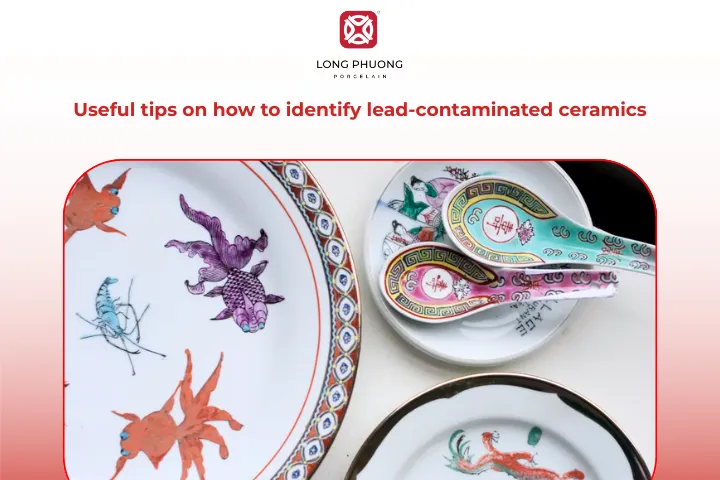
1. Understanding lead in ceramics
1.1. What is lead? Why is it used in ceramics?
Lead is a heavy metal that has been used in pottery for thousands of years because it brings several desirable qualities to ceramic glazes. When added to glaze formulas, lead lowers the melting point, helps pigments blend smoothly, and creates that glossy, glass-like finish people love. This is why many crafted bowls, cups, and plates have such rich colors and a shiny exterior.
The issue isn’t that lead exists in the glaze, but whether it stays locked inside it. In a perfectly formulated and properly fired ceramic piece, lead can remain stable. However, that’s not always the case with older or handmade items.
1.2. Common sources of lead in ceramics
Lead contamination often comes from the materials used to decorate or protect the ceramic surface. The most common sources include:
- Glazes: Many traditional glazes rely on lead compounds to achieve vibrant colors or a smooth finish. Bright shades like orange, yellow, red, and turquoise are especially known for requiring strong pigments that historically included lead.
- Decorative paints: Some ceramics feature hand-painted designs applied over the glaze. These surface paints are more likely to contain lead because they don’t always fuse completely into the ceramic during firing.
- Older glaze formulas: Vintage and antique pottery often predates modern safety regulations, meaning manufacturers frequently used lead-heavy materials without concern for food safety.
These materials don’t necessarily pose an immediate danger, but they become risky when the glaze fails to fully stabilize.
1.3. How lead can leach into food and beverages
Lead becomes a problem when it starts leaching, or slowly dissolving, into anything that touches the ceramic surface. This usually happens when:
- The ceramic was not fired at a high enough temperature
- The glaze formula was improperly mixed
- The surface has cracks, chips, or crazing
- Hot or acidic foods (like coffee, tomato sauce, or citrus) are placed in the dish
When these conditions occur, small amounts of lead can slip into your meals or drinks without altering the taste, smell, or appearance. You won’t notice anything unusual, which makes it easy to underestimate the risk. Over time, even low levels of lead exposure can accumulate in the body and become harmful.

2. Health risks of lead exposure
2.1. Short-term effects
Lead may seem harmless at first because early exposure usually produces vague, easy-to-overlook symptoms. When small amounts of lead enter your body, you might experience issues like headaches, stomach discomfort, irritability, fatigue, or occasional nausea.
These symptoms often resemble everyday stress or minor illness, so most people don’t immediately think lead is the cause. That’s why exposure to something as simple as a ceramic mug or bowl can go unnoticed for long periods.
2.2. Long-term effects
The real danger lies in long-term or repeated exposure. Lead is a cumulative toxin, meaning your body stores it over time instead of flushing it out. As levels build up, the impact becomes far more serious. Prolonged exposure can damage the kidneys, increase blood pressure, and interfere with heart function. It can also affect the nervous system, leading to memory problems, difficulty focusing, mood changes, or even cognitive decline.
In addition, lead can disrupt reproductive health, particularly in women, affecting fertility and pregnancy outcomes. These conditions often develop silently, making prevention even more important.
2.3. Vulnerable groups: kids and pregnant women
Certain groups face even greater risks from lead exposure. Children absorb lead more quickly than adults, and their developing brains and bodies are highly sensitive to its effects. Even very low levels can lead to learning difficulties, behavioral challenges, developmental delays, and long-term cognitive impairment.
Pregnant women are another vulnerable group because lead can cross the placenta. Exposure during pregnancy may harm fetal development, increase the risk of complications, or cause lasting health issues for the baby.
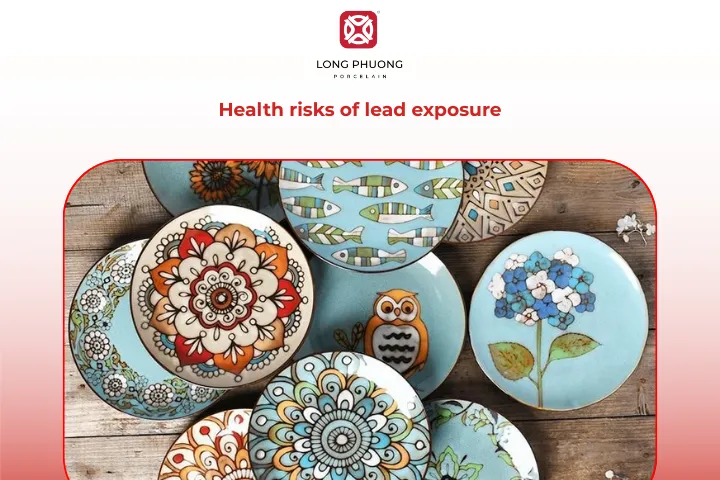
3. Visual signs of lead-contaminated ceramics
3.1. Bright and vibrant glazes
Colors like orange, red, yellow, and deep turquoise often require stronger pigments. Historically, many of those pigments contained lead. While modern regulations have reduced the use of lead, handmade items might still rely on older, unsafe glaze formulas.
3.2. Crazing or fine cracks in the glaze
Crazing refers to the fine, spiderweb-like cracks on the surface of the glaze. These tiny lines may look beautiful, but they increase the likelihood of the glaze breaking down over time. Older or heavily used pottery with crazing is at higher risk of lead leaching into food or beverages.
3.3. Metallic or iridescent finishes
Ceramics with metallic or iridescent glazes can also be a warning sign. These shiny effects sometimes come from lead-containing compounds. Additionally, if the ceramic feels unusually heavy or has a thick, glossy coating, it may indicate older glaze techniques that weren’t designed with safety in mind.
3.4. Raised hand-painted decorations
Be cautious with hand-painted designs applied on top of the glaze rather than under it. If you can feel raised paint when you run your finger over the surface, it may contain lead-based pigments that were not properly fired into the ceramic.
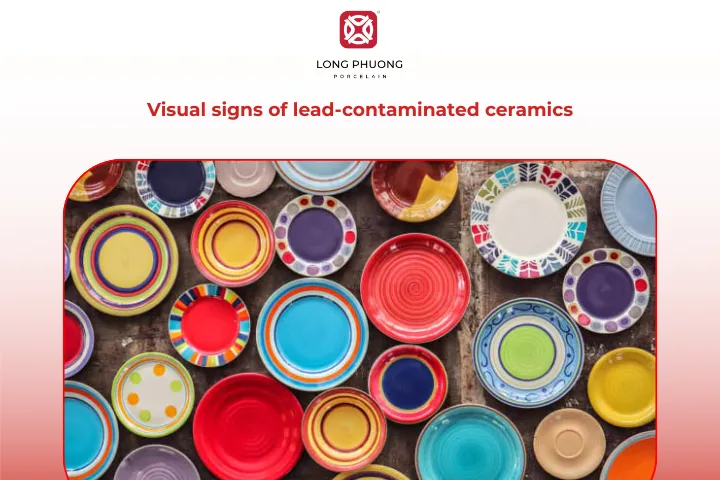
4. Testing methods for lead in ceramics
When it comes to confirming whether a ceramic piece contains lead, testing is your most reliable option. Visual clues help you spot potential risks, but tests give you actual answers. The good news is that you don’t need to be a scientist to check your ceramics. Here is the complete guide on how to identify lead-contaminated ceramics.
4.1. Identify lead-contaminated ceramics at home
4.1.1. At-home test kits
If you want a quick and affordable way to screen your ceramics, at-home lead test kits are a great starting point. These kits usually come with swabs or solutions that react when they come into contact with lead. You simply rub the swab on the ceramic surface, and if the color changes, lead is likely present. They’re user-friendly and easy to find online or in hardware stores.
4.1.2. Vinegar test
This method helps detect lead in ceramics by checking the glaze. Vinegar is acidic and can corrode metals, making it an effective test. Soak the ceramic item in vinegar for 15 to 30 minutes. If the item becomes whitish or the vinegar changes color, it likely contains lead.
4.1.3. Sound test
Regular porcelain is fired at around 1300°C, while lead-containing ceramics are fired at lower temperatures, between 800 and 1100°C. You can gently tap two similar pieces together and listen to the sound. Leaded porcelain produces a dull, muted tone, while lead-free porcelain sounds clear and ringing, like metal striking metal.
4.1.4. Water test
Because leaded porcelain is fired at lower temperatures, its components do not fully bond and remain somewhat porous. You can test this by dropping water on an unglazed area, such as the base. If the water is absorbed, the porcelain may contain lead. Safe porcelain will not absorb water.

4.2. Detect lead in ceramics by doing laboratory testing
For the most accurate results, laboratory testing is the gold standard. Labs use advanced methods like ICP-MS (Inductively Coupled Plasma Mass Spectrometry) or XRF (X-Ray Fluorescence) to detect even the smallest traces of lead.
- ICP-MS provides highly precise measurements, making it ideal for testing food-safe ceramics.
- XRF is a non-destructive technique, meaning your ceramic piece remains intact during testing.
These tests are more expensive, but they’re worth considering for valuable collectibles, family heirlooms, or ceramics used daily for food.
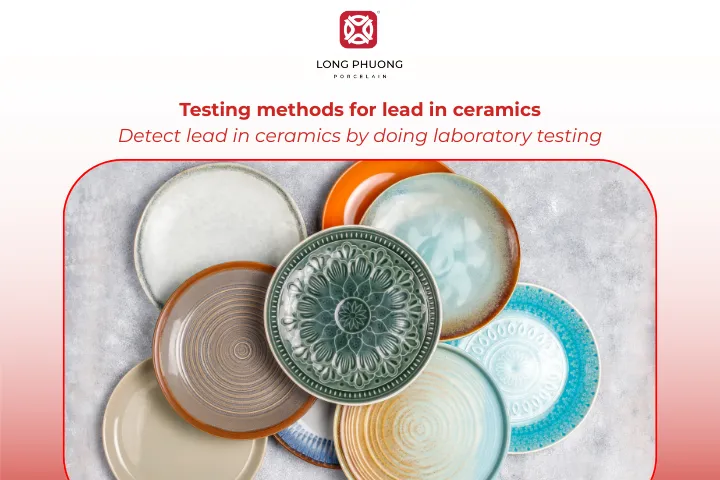
4.3. When should you seek a professional?
If you have a large collection or aren’t sure where to start, hiring a professional inspector can be extremely helpful. Experts can examine your ceramics, identify high-risk pieces, and often perform or coordinate lab testing. This option is handy if you buy antiques, sell ceramics, or frequently use handmade pottery.
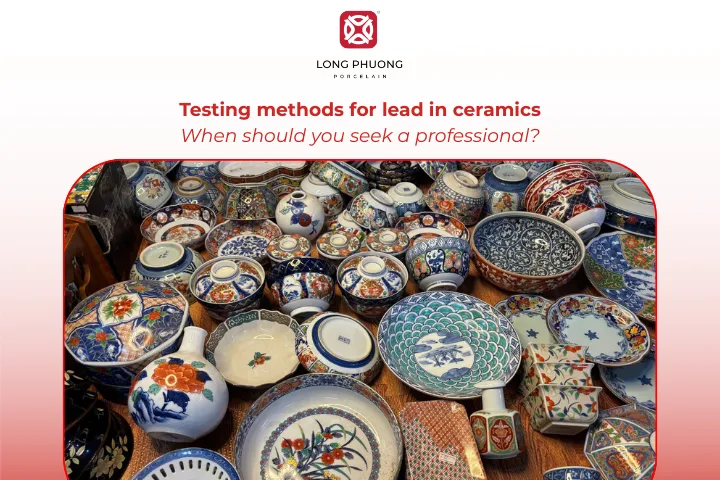
See more: 5 steps in the ceramic processing process you need to know
5. Safe practices when using ceramics
5.1. Avoid using vintage ceramics for food
Older pottery, especially items made before modern safety regulations, often contains lead-based glazes that were not designed with long-term safety in mind. These pieces may be beautiful, but they are better suited for decoration rather than everyday kitchen use.
5.2. Use colorful or decorative ceramics for display only
If you own ceramics with bright colors, metallic finishes, or hand-painted designs, consider reserving them strictly for decoration. Decorative bowls, vases, or plates can enhance your home’s aesthetic without ever coming into contact with food. This approach eliminates the risk of lead exposure.
5.3. Rotate and choose lead-free tableware
For everyday meals, use modern, certified lead-free ceramics. Rotate your tableware so that older or untested pieces are kept for non-food purposes. Most contemporary manufacturers follow strict safety standards, making lead-free ceramics a safer and convenient choice for daily use.
5.4. Inspect for damage and wear
Chips, cracks, and crazing in the glaze increase the likelihood of lead leaching. If you notice any signs of damage, it’s best to remove the piece from kitchen duty or limit its use to dry foods only. Regularly inspecting your ceramics can prevent accidental exposure.
5.5. Look for safety labels
When buying new ceramics, check for labels such as “lead-free,” “food-safe,” or “complies with FDA standards.” These marks give peace of mind and help you build a collection that is both beautiful and safe for everyday use.

6. Common myths about lead in ceramics
6.1. Only old ceramics contain lead
This is one of the biggest misconceptions. While vintage pieces are more likely to contain lead, many modern ceramics can still have unsafe glaze formulas, as not all manufacturers adhere to strict regulations.
6.2. A glossy finish means it’s safe
A glossy finish doesn’t guarantee safety. In fact, lead is often used to achieve that shiny, glass-like surface. The glaze may look perfect on the outside, but lead can still leach through if the firing process wasn’t done correctly.
6.3. Small amounts of lead are harmless
Unfortunately, this couldn’t be further from the truth. Lead is a cumulative toxin, which means your body absorbs it over time. Even small daily exposures can accumulate and eventually lead to serious health problems.
6.4. Detect lead in ceramics by tasting or smelling
Lead is invisible and tasteless. You won’t notice anything unusual, even if a ceramic dish is releasing dangerous amounts into your food. That’s why testing and awareness matter so much.

7. Tips for choosing safe lead-free ceramics
Identifying lead in ceramics is not too difficult, but avoiding lead-contaminated products requires some experience. Here are some useful tips to help you choose safe ceramic ware:
- Choose products with a clear origin. Low-cost or unbranded ceramics usually carry a higher risk of lead contamination.
- Ask the manufacturer about the firing temperature. Household porcelain fired above 1300°C is considered safe because materials used at that temperature must be completely lead-free. If the material contains lead, firing at 1300°C or higher would cause deformation.
- Select items with a bright white glaze that is smooth, even, and free from cracks or peeling.
- Avoid ceramics with overly bright colors or patterns that look wrinkled or rough.
- Do not use bowls or plates with worn glaze, discoloration, scratches, or a rough surface.

8. Choose Long Phuong for clean, safe, and lead-free porcelain
Designed to meet European quality standards, Long Phuong Porcelain products are made from carefully selected materials that are thoroughly tested to ensure they are free from lead, cadmium, and other harmful substances.
Using advanced firing technology at 1380°C, our products deliver outstanding durability with a solid structure that resists impact. The glaze is strong, smooth, and easy to clean, and all pieces are safe to use in both microwaves and dishwashers.
Our items are regularly tested and certified by authorized agencies to confirm that there is no heavy metal contamination.
When you choose Long Phuong, you can feel confident that you are bringing home safe and high-quality porcelain products for your family.
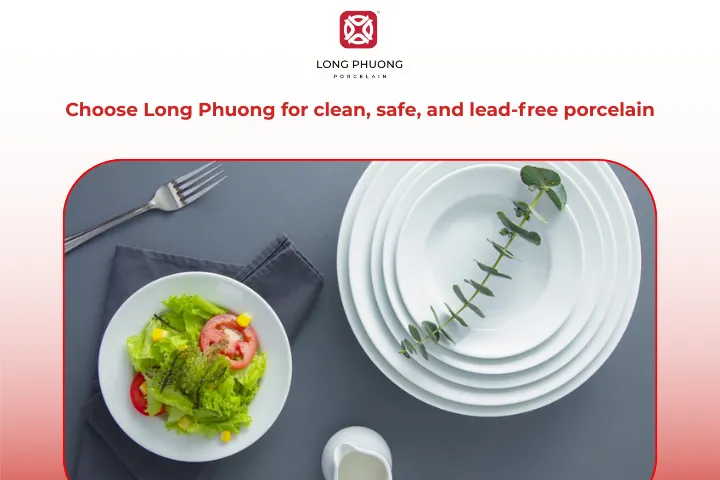
9. FAQs
9.1. Are there any laws against selling ceramicware that contains lead?
Yes. There are regulations in many regions, though they vary in strictness. In the European Union, ceramic tableware intended to contact with food is regulated under the Ceramic Articles Directive (Directive 84/500/EEC), amended by Directive 2005/31/EC.
These set specific migration limits for lead and cadmium. Manufacturers or importers must provide a written declaration of compliance confirming that their products meet these migration limits. In the United States, the FDA has guidance (not strict law) on imported traditional pottery. If ceramicware labeled “lead-free” contains extractable lead above certain action levels, the FDA considers this misleading or unsafe.
9.2. What types of ceramicware may contain lead that can contaminate food?
Some categories are more likely to leach lead:
1. Handmade or traditional pottery, especially low-fired earthenware.
2. Antique or vintage ceramics, since they may use older glazes with lead.
3. Brightly colored vessels, especially orange, red, or yellow, since these pigments are often historically used with lead.
4. Decorative or ceramics from regions without strict quality control or safety standards.
9.3. What’s the difference between “lead-free” and “lead-safe”?
Lead‑free means that the ceramicware is manufactured in a way that results in no detectable or very low levels of lead in the glaze or decoration.
Lead‑safe means that while there might be some lead in the material, it has been tested to ensure that the lead does not significantly leach into food under normal use conditions.
Note: Even if something is labeled “lead‑free,” it’s not a guarantee of safety. The FDA warns that some pottery with that label still has extractable lead above safe levels.
9.4. Can you put leaded dishes in the dishwasher?
It’s not recommended. High-temperature washing, abrasive detergents, or long exposure to water can increase the risk of lead leaching from the glaze. For leaded ceramics that you suspect may leach, limit their use, especially for hot or acidic foods, or consider using them only as decorative items.
9.5. How to tell if your dishes have lead
The most reliable way is to test them. There are at-home lead testing kits (swabs) and also laboratory testing that measures how much lead can actually leach out. In addition, visual risk factors can serve as a warning: cracked glaze (crazing), bright or metallic colors, vintage or handmade appearance, but these only indicate potential, not certainty.
9.6. How to test for lead in ceramics with vinegar?
A commonly suggested DIY approach is to use white vinegar: fill the ceramic piece with vinegar, let it sit (often 24 hours is suggested), then check for signs like discoloration or cloudiness. This can hint at leaching. However, this method is not fully reliable for detecting lead. It doesn’t precisely measure lead content or its leaching rate. For accurate results, professional testing (lab-based) is still the gold standard.
10. Conclusion
Above, Long Phuong Porcelain has guided you on how to identify lead-contaminated ceramics. We hope this article gives you valuable information to help you choose high-quality and safe pieces that protect your health and the well-being of your loved ones.
Related articles
CEO of Long Phuong Group Joint Stock Company, with more than 20 years of exploration and research to obtain the best formulas and professional experience, Long Phuong Porcelain has produced more than 400 designs of all kinds of household porcelain, Significant contributions to Vietnam's ceramic industry.
 Vietnam
Vietnam
